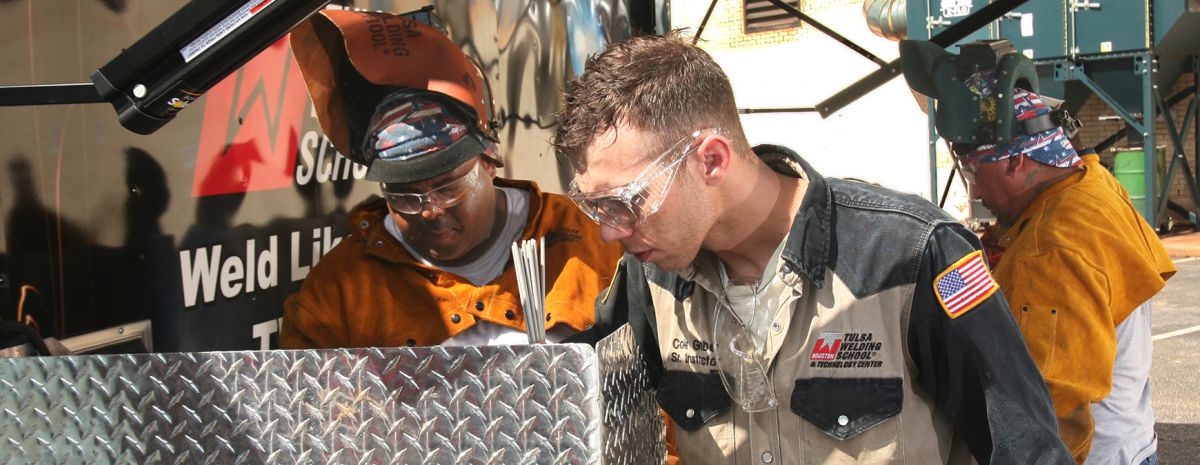TWS is a Great Training Option for Everyone
Learn more about how we can prepare you to advance your career.
If you’re a welding student or graduate, or if you’re currently exploring the idea of welding as a career, you may be wondering about the difference between some of the terms used in the industry. You might have heard the terms “qualified welder” and “certified welder.”
Qualified Welder vs. Certified Welder
The term “qualified welder” is not associated with any official third-party accredited agency, organization, or exam. There is no objective or organized “qualified welder test.” However, the term “qualified welder” may be used to refer to a welder who has passed any kind of qualification test.1
Welding employers sometimes have company-specific welding tests that they want their job applicants to pass before offering them a job. If a welder passes a private welding test to get a job, you could say he or she is a “qualified welder.” In other words, they are qualified to perform certain welding tasks or to perform a job based on their skills.1
The term “certified welder,” on the other hand, usually refers to a specific, organized, accredited third-party welding certification. One common certification is the Certified Welder (CW) program offered by the American Welding Society (AWS). If someone is a “certified welder,” this most commonly means they have taken and passed a third-party accredited test that is verified and accepted across the welding industry.1
Have You Considered a Career in the Skilled Trades?
Fill out the form to recieve a no obligation info packet.
It is, of course, possible to pass the CW exam and pass a company’s private welding exam to be both a certified welder and qualified welder. The difference in terms is mostly important to know because “certified welder” refers to an official status conferred by a welding organization and “qualified welder” is not associated with any specific organization. Both terms indicate that a welder has a certain level of welding skill.1
How to Prepare for a Certified Welder Exam

The Certified Welder exam offered by the American Welding Society does not require any official prerequisites or classes. Anyone who feels they have the skills necessary to pass the test is eligible to apply. The test is entirely performance-based and open to anyone with a talent in welding.2
The CW exam consists of welding procedures in the structural steel, sheet metal, chemical refinery, and petroleum pipeline industries.3 The test can be specific to certain welding processes, such as SMAW, GMAW, or FCAW, as well as specifically tailored to different usage of gases, base metals, filler metals, metal thickness, and welding position.4
Since there is no official perquisite, the best way to prepare for a certified welder exam is to learn and practice your welding skills.3 There are many ways to learn the technical skills of welding, such as in high school shop class, in the U.S. armed forces, at a community college, or at a vocational school.5 The most important way to prepare for the CW exam is to learn the trade from other experienced welders and practice your welding techniques.
The Professional Welder program at Tulsa Welding School (TWS), for example, is a 7-month long program that provides a welding lab and class instruction to transfer real-world welding skills to students. SMAW, MIG, TIG, and fluxed-core arc welding are some of the common welding techniques that you can learn in welding school.
This welding program teaches:
- The fundamentals of welding
- How to read blueprints
- Understanding welding symbols
- Using welding machines
Completing the welding training program at TWS prepares students for an entry-level job in welding and entry-level tests such as the CW certification.
How much does the CW test cost?
While the CW application fee is a flat $50, the cost of the test itself may vary across testing facilities. As of 2021, AWS recommends that interested parties contact an Accredited Testing Facility (ATF) directly for testing fees.6
You can find an Accredited Testing Facility here. The TWS campus in Jacksonville, Florida, is an ATF site. At this location, the test fee for current or past students is $200. Non-students can take the test for $500. Please contact the ATF office for more information at 1-904-345-5593.
What to Know for a Certified Welder Test
On a CW test, you will need to be prepared to do the following:
- Identify proper welding materials.
- Follow safety protocols.
- Follow all specified welding procedures.
- Use a welding machine.
- Assemble joints.
- Weld in the correct position.
- Perform a sound weld.2
- Have your weld inspected by an AWS Certified Welding Inspector (CWI).2
Other important information to know when preparing for the CW test can be found at the AWS certification page.
- You will need to fill out the AWS Certified Welder Application.
- You should review all the official Standards for AWS Certified Welders when preparing for the exam. This document includes topics such as testing arrangements, weld tests, physical requirements, retests, reporting, and certification renewal.7
- You can also review the Guide to Interpreting Abbreviations on AWS Certified Welding Card.
Good luck! Once you pass the test, you should receive your Certification card within 4-6 weeks.2
1https://www.thefabricator.com/thewelder/article/arcwelding/arc-welding-101-qualified-versus-certified-what-s-the-difference-
2https://www.aws.org/certification/cw_faqs
3https://www.aws.org/certification/page/certified-welder-program
4https://www.aws.org/library/doclib/certifications-that-a-welder-can-obtain.pdf
5https://www.bls.gov/ooh/production/welders-cutters-solderers-and-brazers.htm#tab-4
6https://www.aws.org/library/doclib/2021-CERT-PROGRAM-PRICELIST.pdf
7https://www.aws.org/library/doclib/QC7-93.pdf
This blog has been labeled as archived as it may no longer contain the most up-to-date data. For a list of all current blog posts, please visit our blog homepage at https://www.tws.edu/blog/







